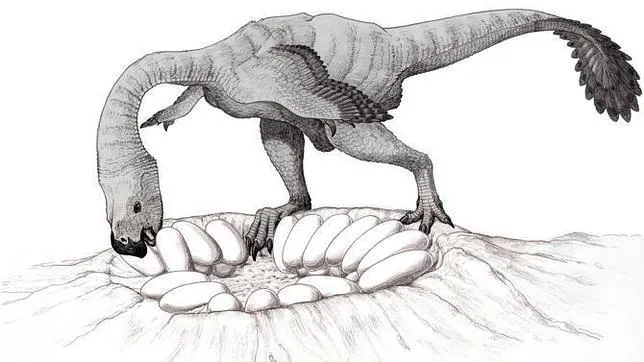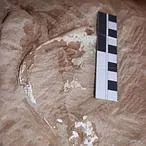
Cuando
los paleontólogos dejaron de cavar y contemplaron lo que habían
descubierto se quedaron estupefactos. Tenían ante sus ojos una escena
maternal ocurrida hace 70 millones de años. Una hembra de oviraptor -una especie de dinosaurio emplumado de unos 2 metros de largo que recuerda a las aves-, perfectamente fosilizada, empollaba 20 huevos en un nido.
La escena entera, tal y como estaba ocurriendo entonces, había llegado
hasta nuestros días prácticamente intacta. El impactante hallazgo fue
realizado por investigadores italianos y canadienses en 2007 en el
desierto del Gobi y ahora aparece descrito con todo detalle en un
artículo de la revista científica PLoS ONE.
Los
oviraptor han sido una fuente de especulación sobre el comportamiento
de los dinosaurios terópodos no avianos durante décadas, ya que se
creía, erróneamente, que eran ladrones de huevos, cuando en realidad cuidaban de los suyos. La expedición realizada en 2007, en la que participaba el científico canadiense John Philip Currie,
famoso por sus estudios sobre dinosaurios, e investigadores de la
Universidad de Bolonia, descubrió dos nuevos especímenes de Oviraptor en
la formación de Baruungoyot, en Mongolia. Uno de ellos se encontraba
sobre un nido con huevos, en posición de empollarlos. A pesar del paso
del tiempo, algunas de las partes del animal estaban muy bien
conservadas, incluidos el cráneo y las patas. El segundo espécimen, algo
más pequeño, fue encontrado a unos kilómetros con sus patas y el fémur
preservados.
Turnos para empollar
Los
paleontólogos creen que estos animales se adaptaban bien a su entorno y
eran capaces de vivir tanto en ambientes desérticos como fluviales.
Además, poseían una sofisticada estructura social que incluía el empollamiento de los huevos en nidos especialmente preparados. Los adultos hacían turnos para cuidar de sus futuras crías. Los
fósiles encontrados por los investigadores también ayudan a disipar
definitivamente la idea errónea de que el oviraptor era un ladrón de
huevos (es lo que significa su nombre en latín). La primera vez que un
fósil de este dinosaurio fue descubierto, su cabeza se encontraba cerca
de un nido, lo que se confundió con un acto depredador.
Figure 1. The Nemegt locality the Gobi Desert, southern Mongolia.
A,
map showing the location of the study area within southern Mongolia; B,
the Nemegt area is located a few kilometers south of the massif of the
same name; C, a detail of the Nemegt locality (sensu 5), showing the exact locations of specimens described in this study.
Figure 2. Location map showing the position of the measured section discussed in the text.
A, Northern Sayr,
where specimen was collected. B, lithostratigraphic logs
showing the relative stratigraphic occurrence of the interfingering
Baruungoyot and Nemegt formations. C, In-situ and partially reworked
caliche glaebules and concretions, Baruungoyot Formation. D, tubular
burrow fills interpreted as nonmarine invertebrate feeding traces,
Baruungoyot Formation. E, cross-bedded deposits in the basal deposits of
the Nemegt Formation. F, photograph showing the interfingering contact
between the Baruungoyot and Nemegt formations in the Northern Sayr
(litho-log c). MPC-D 107/15 was collected just below the Nemegt tongue
deposits.
Figure 3. Nest and preserved elements of Nemegtomaia barsboldi
A, dorsal view; B, left lateral view; C, right lateral view; D, posterior view. lf, left femur; lfi, left fibula; lh, left humerus; lm, left manus; lp, left pes; lpu, left pubis; lr, left radius; ls, left scapula; lt, left tibia; lu, left ulna; rf, right femur; rfi, right fibula; rh, right humerus; rp, right pes; rpu, right pubis; rs, right scapula; rt, right tibia; sk, skull. Scale bar 10 cm. Reconstruction by Marco Auditore.Articular surfaces have been completely obliterated in the left forearm (A), left leg and pes (B), as well as in the right forearm (C). Circular borings are particularly evident in the left side of the skull (D–F). G, Bone-chip burrow found under the skull of the specimen. H, large traces of reworked sediment under the skeleton.
A, preserved elements of the right side; B, preserved elements of the left side; C, reversed elements of the left side superimposed to those of the right side (where elements of both sided overlap, the grey is darker); D, reconstruction of the skull.an, angular; d, dentary; ec, ectopterygoid; eo, exoccipital; f, frontal; j, jugal; l, lacrimal; m, maxilla; n, nasal; p, parietal; pm, premaxilla; po, postorbital; q, quadrate; qj, quadratojugal; sa, surangular; sq, squamosal; sr, sclerotic ring. Scale bar 10 cm. Illustration by Marco Auditore.
A, preserved elements and reconstructed manus of MPC-D 107/15 in dorsal (a1) and lateral (a2) views: B, right manus of MPC-D 107/16 in dorsal (b1) and medial (b2) views; C, left manus of MPC-D 107/16 in medial (c1) and dorsal (c2) views, with the preserved distal portions of radius and ulna. lr, left radius; lu, left ulna. Scale bar 5 cm. Illustration by Marco Auditore
A, the holotype (MPC-D 100/2112); B, MPC-D 107/15 (the left side of the skull, left forelimb, pubis and toes are reversed and superimposed to the right side). C, MPC-D 107/16 (the left forelimb is reversed and superimposed to the right side). In D, the preserved elements of MPC-D 107/15 and 16 are scaled to and superimposed on the holotype (the skull depicted is that of the better preserved MPC-D 100/2112). Scale bar 20 cm.
A, disposition of preserved eggs within the nest. Eggshells have been recovered under the skull (B), left pes (C) and leg (D), suggesting the direct apposition of the oviraptorid on top of the eggs. During the early excavation of the nest, it was possible to document a lower layer of eggs lying approximately 10 cm below the body (E–G).








